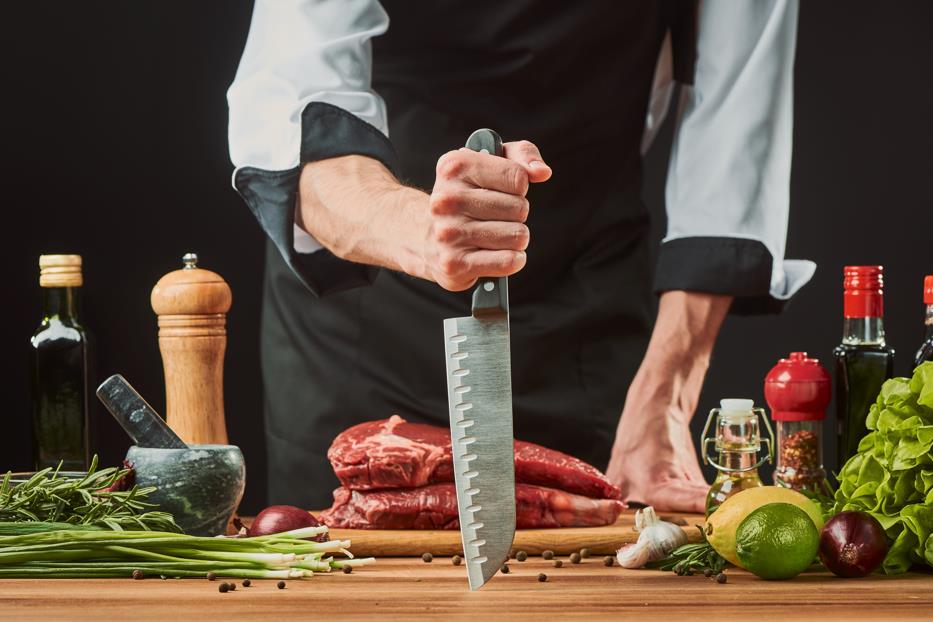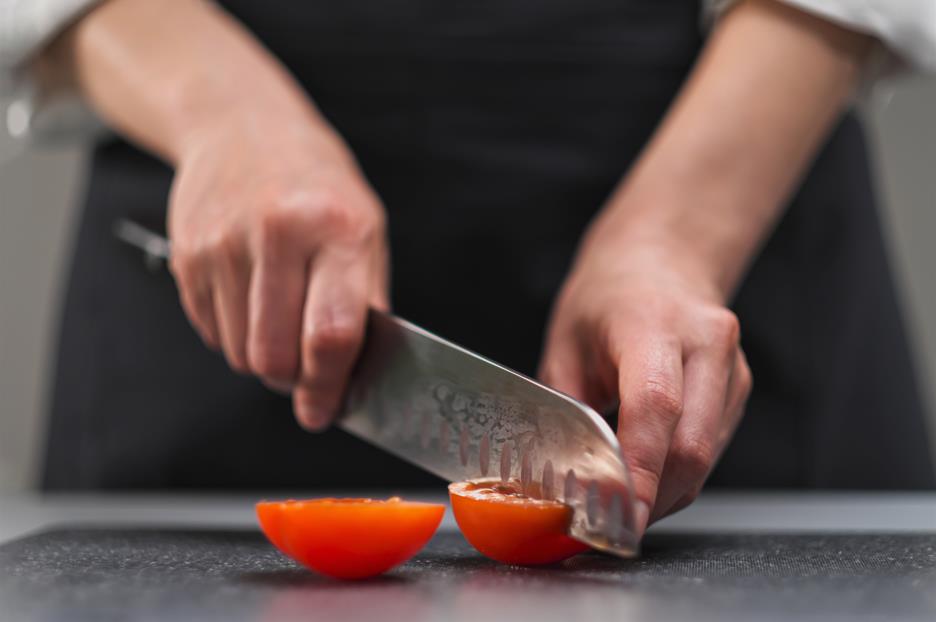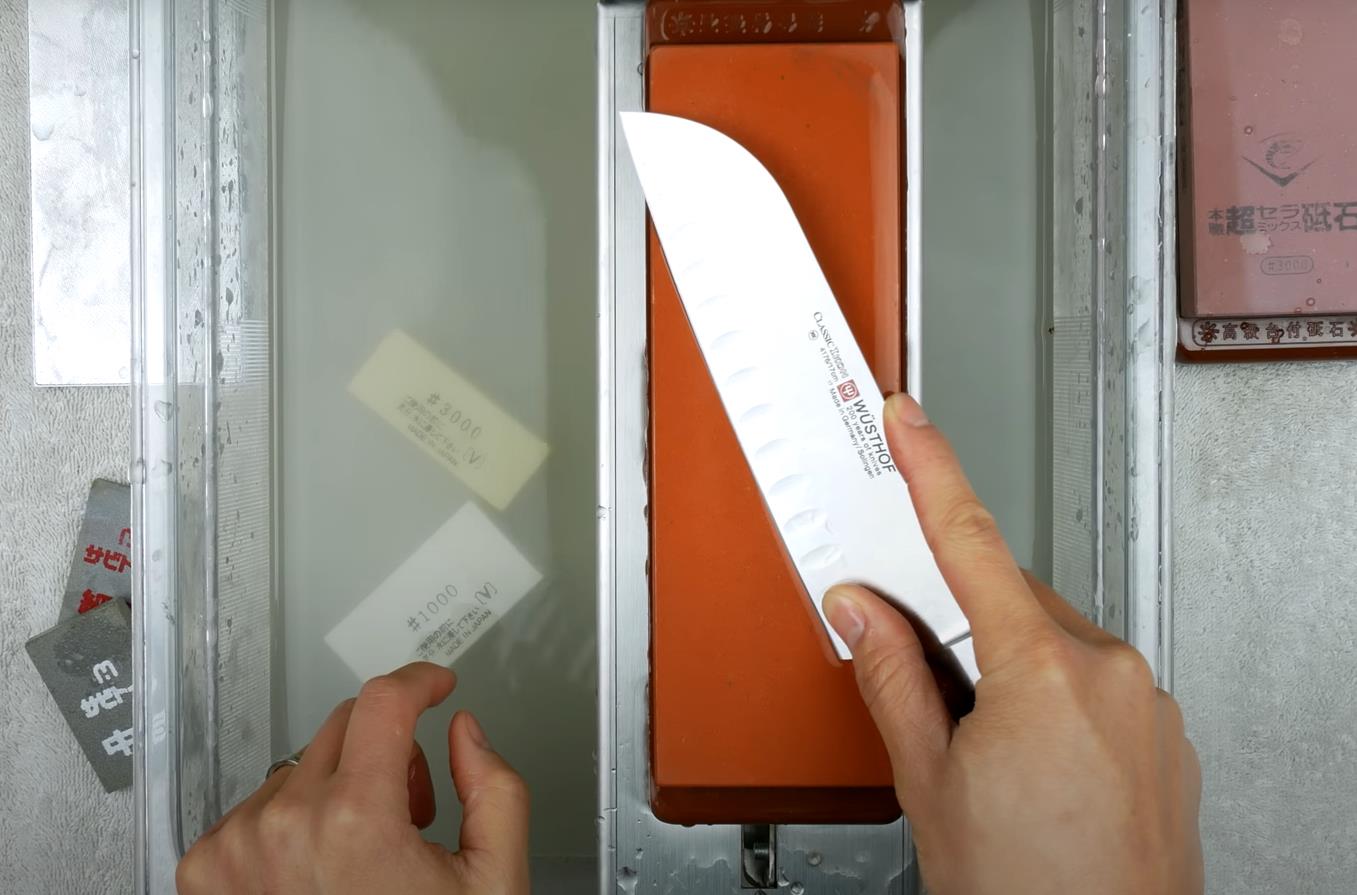It can be pretty challenging to have entire pieces when cutting foods. This is difficult in particularly with creating thinly sliced pieces. The constant struggle of slicing and the foods tearing apart isn’t something anyone would want on their plate.
There is also the battle with the slices sticking to the blade. Even if your knife is razor-sharp, the foods might stick due to the moisture or steam, making it hard to release the blade. Using your fingers to detach the food from the knife is not something that you would want to do every time you slice something. This is a problem with cutting certain foods like briskets, cucumbers, tomatoes, and other watery edibles.
A Granton edge knife might be the solution if you have these struggles often. This article will detail everything you need to know about Granton edge, what makes them great, and why you should have it in your arsenal of kitchen knives.
Table of contents
How Granton edge works?

Granton edge knives have unique scallops along the sides of the blade. These hollow parts create air pockets that get in the way of anything that can make the slices stick to the blade. This feature essentially helps release the food without using external forces like your hands.
The scallops don’t extend down in a Granton edge knife despite the name. These knives have a straight edge, the same as most other kitchen knives. The scallops are also alternated on both sides of the blade to increase the overall strength. Regardless of what part of the blade you’re using to cut, the pockets will be there to ensure that foods don’t stick.
The benefits of a Granton edge aren’t just supporting foods falling right to the cutting board. The best benefit of a Granton edge is that the cuts are always whole without tears that mess up the look of the portions, which makes it favorable to any cook. As a by-product of the foods not sticking to the blade, slices remain without breaking. This trait comes in handy when cutting particularly fragile foods like fatty fish and cheeses.
Who manufactures Granton edges?
Granton edge is native to Granton knife company based in Sheffield, England. Since they were the masterminds behind this unique blade design, many knife manufacturers picked up the name to describe these types of blades.
While the Granton knife company first introduced this special blade design, many manufacturers followed suit. Nowadays, most knife manufacturers have Granton edge knives, whether they be paring knives, chef’s knives, or even Japanese knives like Santoku and Kiritsuke.
What types of knives come with a Granton edge?
Manufacturers give their blades a Granton edge to have extra features on top of what they’re offering. After all, the Granton edge is a trait that any knife can have regardless of its size, shape, and steel. Whether it’s a paring knife, chef’s knife, or any other, it’s one of the most valuable elements any kitchen knife can have.
Here are some of the knives that commonly come with a Granton edge.
Granton edge slicing knife
Slicing knives come with a long, thin blade; and generally have a pointy tip. The blade’s design makes it easier to slice and ensures that it doesn’t get stuck between foods. Added with a Granton edge, they perform exceptionally well, and you can use them to cut anything. A large portion of slicing knives is finished with a Granton edge that you’ll find them easily at stores.
Granton edge santoku

As a whole, the Japanese santoku knives have thicker blades than a chef’s knife. Although they are efficient in any kitchen duties, slicing and making delicate cuts can be difficult due to the blade’s design. That’s why many santoku knives have a Granton edge that makes it easier for cooks to slice any ingredient.
Granton edge butcher knife
Butcher knives also feature a reasonably thick blade. When preparing large chunks of meats, getting the blade wedged will prevent butchers from getting smoothly cut pieces. That’s why countless butcher knives have a Granton edge, especially those with long blades used to cut sirloin and ribs.
Best handmade plain edge knives
True cutting power in the palm of your hand
Why should you use Granton edge knives?
It can be a hassle to prevent foods from sticking to the blade when slicing. Cutting and releasing the foods from the blade with your hands every time you make a slice can get pretty boring quickly. It’s also not very time-efficient. Why take every piece when you can just slice and be done with it altogether? That’s where a Granton edge knife proves its usefulness.
When slicing, steam and moisture released from foods can act as a sticky substance that clings onto the blade. The hollow parts act as air pockets that won’t trap moistness, and the slices will fall right off to the cutting board. As the scallops are on both sides of the blade, it won’t matter whether you’re making delicate cuts or carving foods.
Although a Granton edge knife works on very simple principles, its effectiveness can benefit every cook. What these special knives have to offer is definitely worth having, and that’s why you should have a Granton edge knife as part of your kitchen knives.
Granton edge pros and cons
| Pros | Cons |
| Doesn’t get wedged into foods | Some may find it harder to sharpen |
| Doesn’t tear or break foods | Relatively thick blade and spine |
| Easier to cut large, thick ingredients |
Granton edge vs scalloped edges
As briefly mentioned, the Granton edge doesn’t extend down to the edge and has a straight cutting edge. In a way, it’s more a feature of the blade rather than the edge.
On the other hand, scalloped edges are more like serrated knives that saw through foods instead of slicing through. They’re a lot like bread knives that unquestionably come in handy in many kitchen tasks like carving up ingredients with thick skin but aren’t helpful when you want tear-free slices.
Even when making the initial contact, foods always tear it as scalloped edges don’t slice but saws through the ingredients. Because a Granton edge knife has a straight cutting edge that isn’t different from a regular chef’s knife, the dimples don’t have anything to do with cutting, whereas the scalloped edges cut the foods.
Most cooks prefer a straight cutting edge over the other, but scalloped edge knives have their own uses that are beneficial in certain situations.
How to sharpen a Granton edge knife?

Due to the straight cutting edge, the Granton edge knives don’t require a special sharpening procedure. The scallops have nothing to do with the sharpening process. You can sharpen a Granton edge kitchen knife the same way you would sharpen any other kitchen knife. Here are some of our resources to help you sharpen not just a Granton edge knife but any other.
- Ultimate Knife Sharpening Guide: All You Need to Know
- How to Use a Sharpening Stone or Whetstone
- How to Sharpen a Knife Without a Sharpener (DIY)
Overall, the Granton edge is extremely convenient, and any kitchen knife can have it. Learn more about different kinds of kitchen knives on our blog and head to our collection to see top-of-the-class handmade knives.












